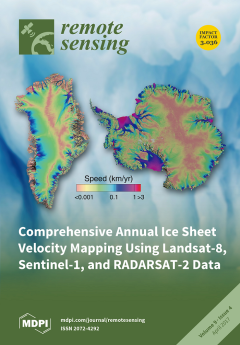Actual evapotranspiration (
ET) is a major water use flux in a basin water balance with crucial significance for water resources management and planning. Mapping
ET with good accuracy has been the subject of ongoing research. Such mapping is even more challenging
[...] Read more.
Actual evapotranspiration (
ET) is a major water use flux in a basin water balance with crucial significance for water resources management and planning. Mapping
ET with good accuracy has been the subject of ongoing research. Such mapping is even more challenging in heterogeneous and data-scarce regions. The main objective of our research is to estimate
ET using daily Moderate Resolution Imaging Spectroradiometer (MODIS) land surface temperature and Global Land Data Assimilation System (GLDAS) weather datasets based on the operational simplified surface energy balance (SSEBop) algorithm at a 1-km spatial scale and 8-day temporal resolution for the Mara Basin (Kenya/Tanzania). Unlike previous studies where the SSEBop algorithm was used, we use a seasonally-varying calibration coefficient for determining the “cold” reference temperature. Our results show that
ET is highly variable, with a high inter-quartile range for wetlands and evergreen forest (24% to 29% of the median) and even up to 52% of the median for herbaceous land cover and rainfed agriculture. The basin average
ET accounts for about 66% of the rainfall with minimal inter-annual variability. The basin scale validation using nine-years of monthly, gridded global flux tower-based
ET (GFET) data reveals that our
ET is able to explain 64% of the variance in GFET while the MOD16-NB (Nile Basin) explains 72%. We also observe a percent of bias (PBIAS) of 1.1% and 2.8%, respectively for SSEBop
ET and MOD16-NB, indicating a good reliability in the
ET estimates. Additionally, the SSEBop
ET explains about 52% of the observed variability in the Normalized Difference Vegetation Index (NDVI) for a 16-day temporal resolution and 81% for the annual resolution, pointing to an increased reliability for longer aggregation periods. The annual SSEBop
ET estimates are also consistent with the underlying primary (i.e., water and energy) and secondary (i.e., soil, topography, geology, land cover, etc.) controlling factors across the basin. This paper demonstrated how to effectively estimate and evaluate spatially-distributed and temporally-varying
ET in data-scarce regions that can be applied elsewhere in the world where observed hydro-meteorological variables are limited.
Full article





